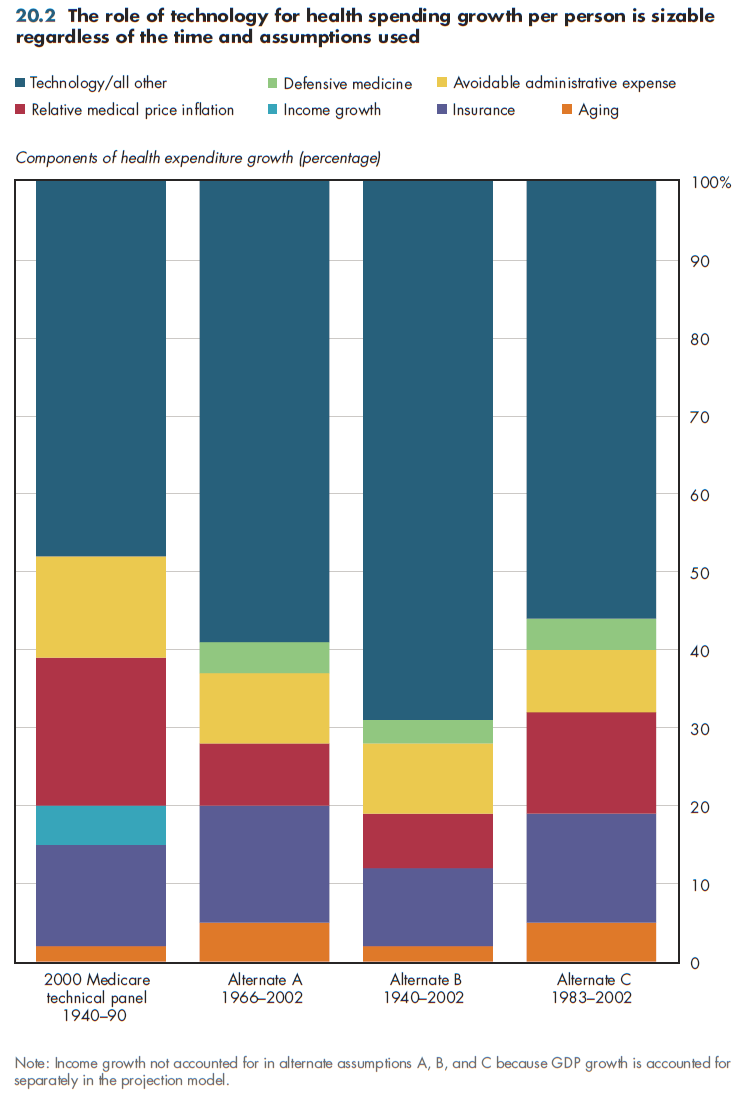Download PowerPoint versions of figure.
Inside Collection (Book): American Health Economy Illustrated
20.2 Technology Has Been a Key Driver of Health Spending Growth
Summary: Technology has been a far more important driver of health spending growth during the past 60 years than has population growth or aging.
Technology and other factors appear to account for approximately half or more of the growth in per capita health spending over the past 60 or more years. As figure 20.2 illustrates, the exact amount depends on the period examined and other methodological assumptions.

The exact contribution of technology is unknown (recall figure 17.3). When analysts have accounted for all the other major factors that contributed to the rise in inflation-adjusted health spending per person (for example, medical price inflation), most of the "residual" that cannot be explained is attributed to technology. Some of it is an income effect, a willingness to purchase medical services (for example, Lasik surgery) if a person has a higher income, but a person who has a lower income was not willing to purchase it. It is difficult to separate out accurately the effect of income from technology. Some would also argue that calculations such as these underestimate the role of insurance in encouraging the development of technology.
However it is defined, this "residual" is what government forecasters use to determine how fast health care expenditures will increase in the future. They can use demographic models to calculate how quickly the population is increasing and how the age-gender mix of the population is changing over time. Relative spending changes over the life cycle, depending on gender (refer to figure 12.5). Thus, if everything were static, it would be a straightforward mathematical exercise to determine how much total spending will rise because of such demographic changes.
However, the big unknown is how much per-person spending for everyone is likely to rise beyond growth in the general economy. To answer this question, fore- casters have no choice but to look to the past. They cannot avoid making assumptions about the future. The 2000 Medicare Technical Panel estimated that per capita annual growth in health care spending would be 2.2 percent a year and that long-run real per capita GDP growth would be 1.2 percent. This implies that health spending growth would exceed GDP growth by one percentage point a year. Thus, they recommended using "GDP + 1" (that is, 1.2 percent plus 1 percent) as the basis for projecting health spending over the next 75 years. The Medicare Trustees' reports from the year 2000 forward all have used this assumption in deriving long-term projections (i.e., years 25 through 75 of the projection period).
Downloads
References
- Brown JD and RM Monaco. Possible Alternatives to the Medicare Trustees' Long-Term Projections of Health Spending. US Department of Treasury. Office of Economic Policy. 2004.
Collection Navigation
- « Previous module in collection 20.1 Projected Growth in Health-Related Benefits
- Collection home: American Health Economy Illustrated
- Next module in collection » 20.3 How Much Faster per Capita Health Spending Has Increased Relative to GDP Growth
Content actions
Give feedback:
Download:
Add:
Reuse / Edit:
Twin Cities Campus:
- © 2012 Regents of the University of Minnesota. All rights reserved.
- The University of Minnesota is an equal opportunity educator and employer. Privacy
- Last modified on Sep 24, 2013 3:23 pm -0500









